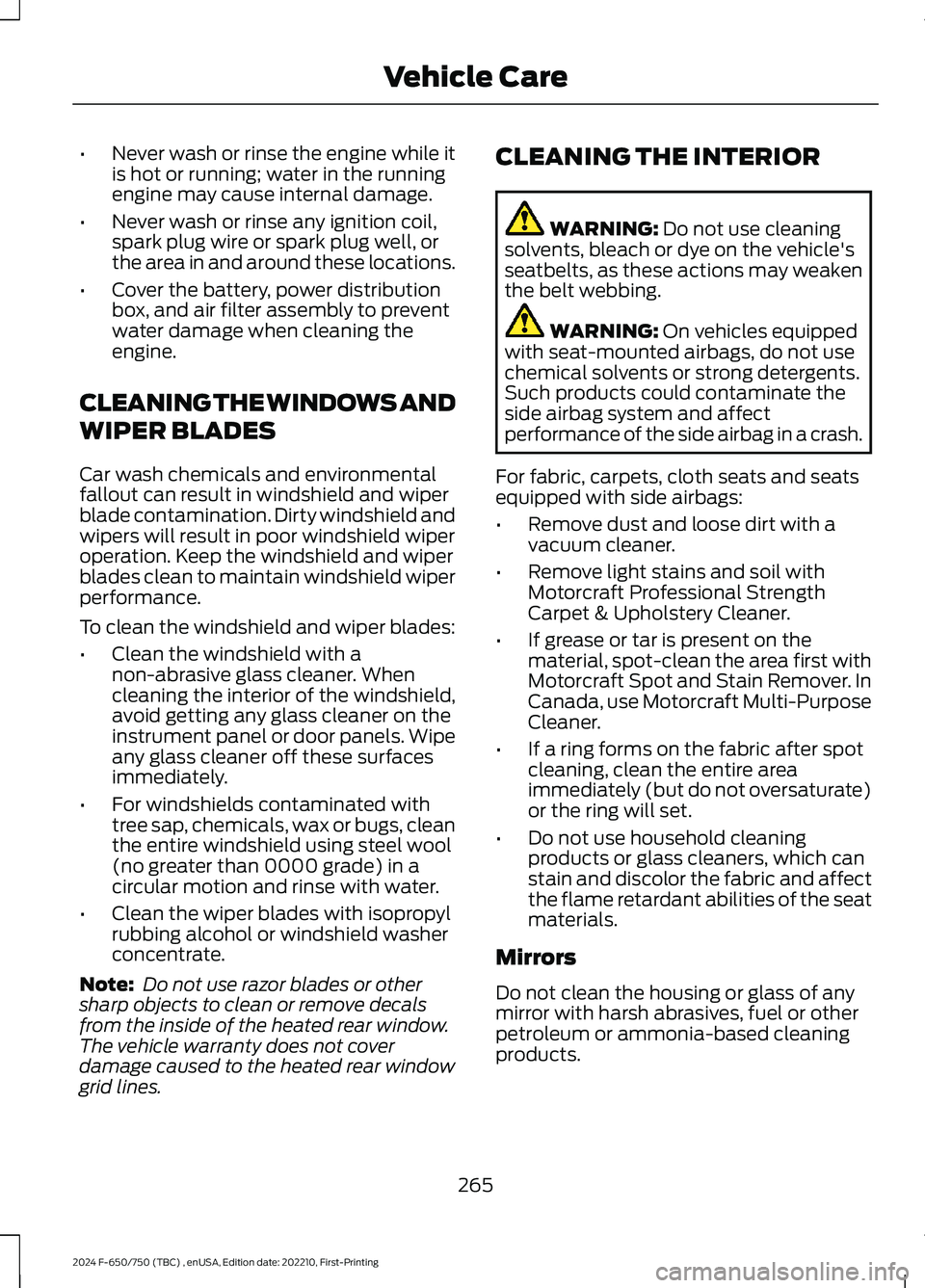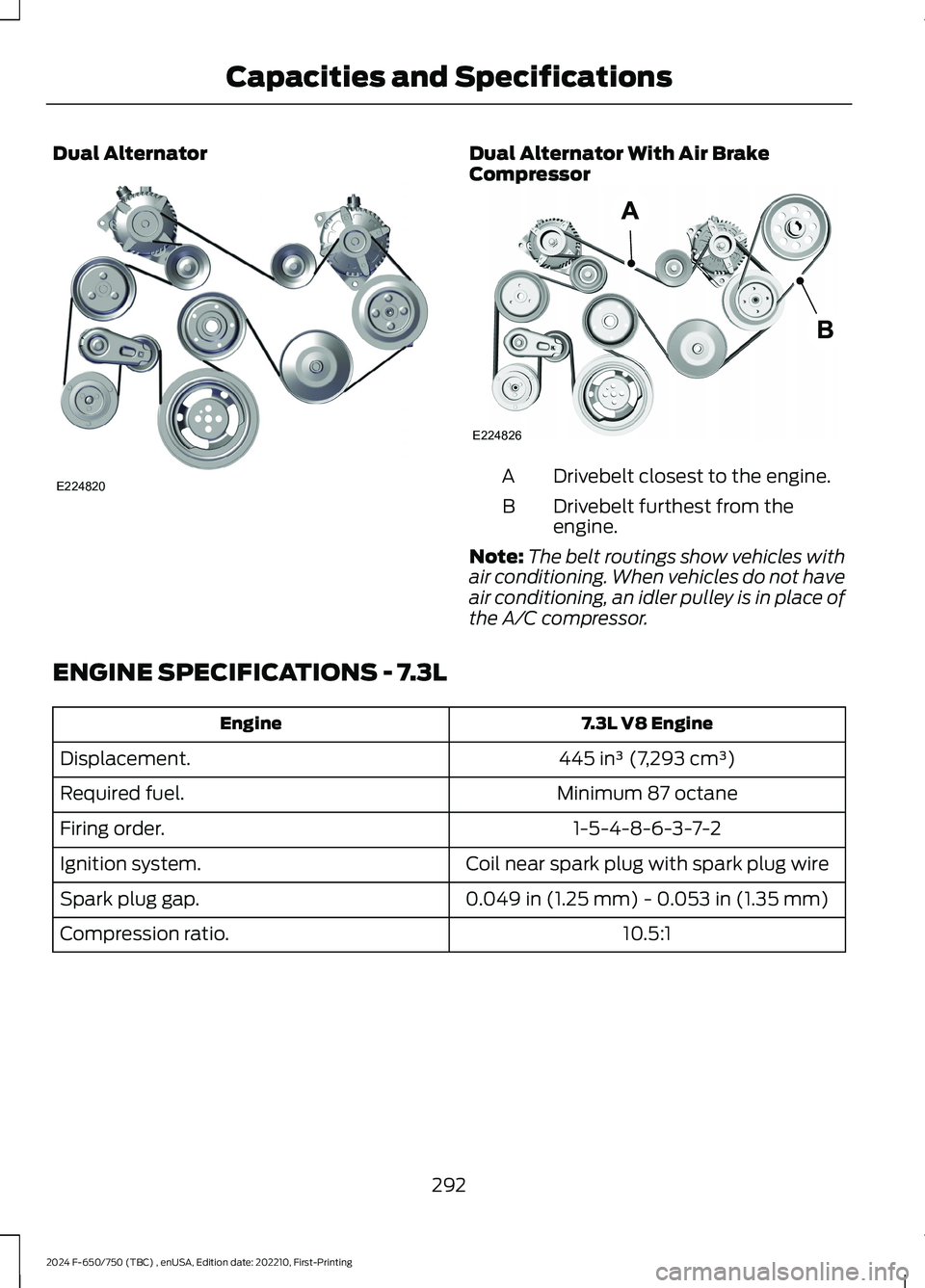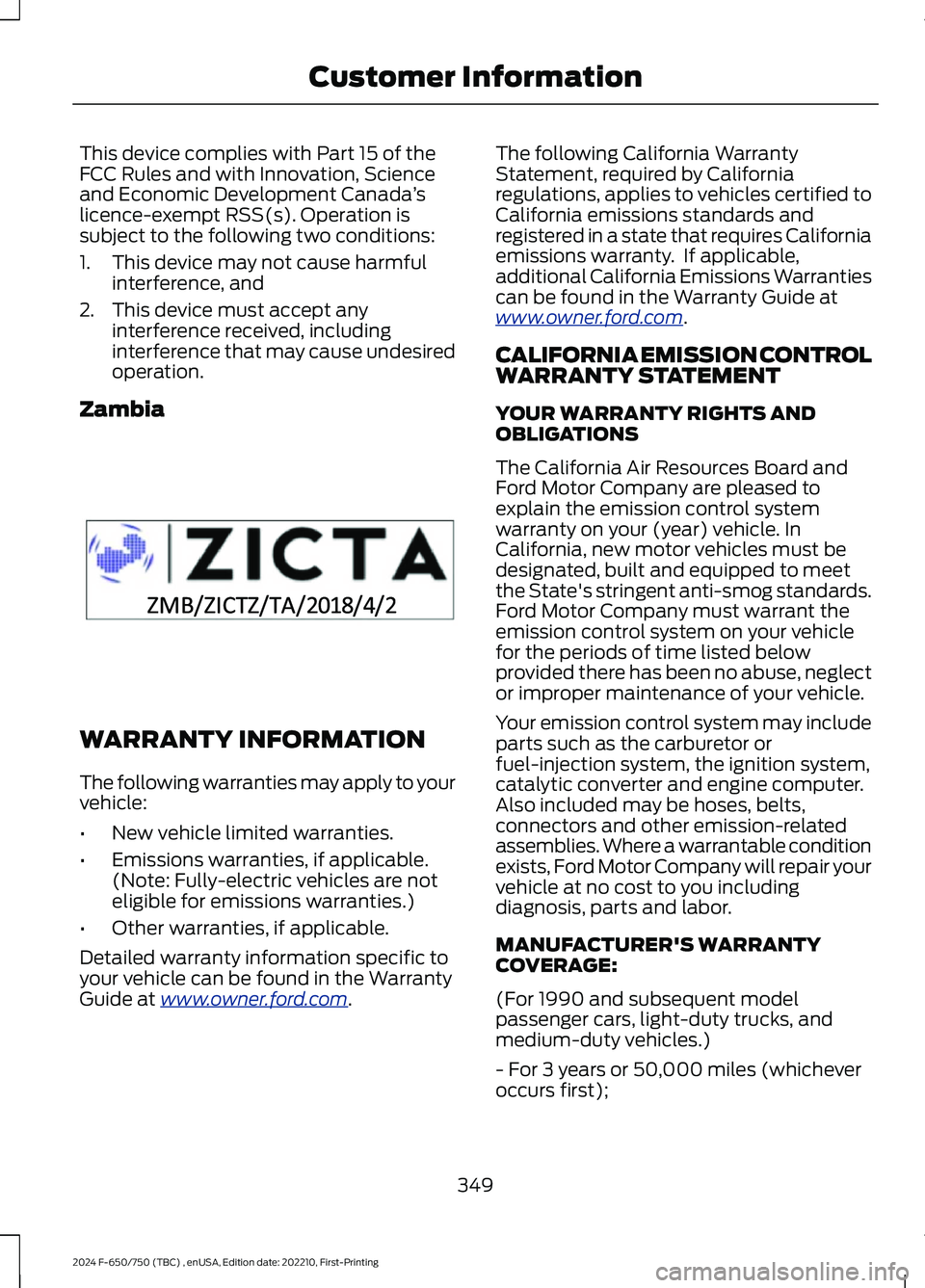2024 FORD F650/750 ignition
[x] Cancel search: ignitionPage 258 of 386

Removal
1.Disconnect the fuel lines by squeezingthe connector tabs and pulling the linesstraight off.
2.Rotate the filter fully counterclockwiseuntil the peg is at the far end of the slot.
3.Pull the filter straight up from thebracket and discard the filter.
Installation
1.Install the new filter into the filterbracket. Turn the filter clockwise tolock it in place.
2.Reconnect the fuel lines.
3.Switch the ignition on for 30 secondsand then switch the ignition off.Repeat this operation six times in a rowto purge any trapped air from the fuelsystem.
ELECTRICAL SYSTEM
INSPECTION
Periodically inspect electrical connectorson the outside of the cab and on the engineand frame for corrosion and tightness.Exposed terminals, such as the fuel sender,cranking motor, alternator andfeed-through studs, should be cleaned andre-coated with a lubricant sealing greasesuch as Motorcraft Silicone Brake CaliperGrease and Dielectric Compound XG-3, orequivalent. This should include the groundcable connector for batteries, engine andcab as well as the jump-starting stud.
Accessory Feed Connections
Vehicle electrical systems are complex andoften include powertrain components,such as engine and transmission controls,instrument panels and ABS. While mostsystems operate on battery voltage (12volts), some systems can be as high as 90volts or as low as five volts. See theElectrical Circuit Diagram Manuals,available from your vehicle’s manufacturer,to make sure that any extra body lights andaccessory connections to circuits are bothappropriate and not overloaded. Do notmake modifications to any vehicle controlsystem without first contacting anauthorized dealer.
254
2024 F-650/750 (TBC) , enUSA, Edition date: 202210, First-PrintingMaintenanceE2262151 E22621423
Page 269 of 386

•Never wash or rinse the engine while itis hot or running; water in the runningengine may cause internal damage.
•Never wash or rinse any ignition coil,spark plug wire or spark plug well, orthe area in and around these locations.
•Cover the battery, power distributionbox, and air filter assembly to preventwater damage when cleaning theengine.
CLEANING THE WINDOWS AND
WIPER BLADES
Car wash chemicals and environmentalfallout can result in windshield and wiperblade contamination. Dirty windshield andwipers will result in poor windshield wiperoperation. Keep the windshield and wiperblades clean to maintain windshield wiperperformance.
To clean the windshield and wiper blades:
•Clean the windshield with anon-abrasive glass cleaner. Whencleaning the interior of the windshield,avoid getting any glass cleaner on theinstrument panel or door panels. Wipeany glass cleaner off these surfacesimmediately.
•For windshields contaminated withtree sap, chemicals, wax or bugs, cleanthe entire windshield using steel wool(no greater than 0000 grade) in acircular motion and rinse with water.
•Clean the wiper blades with isopropylrubbing alcohol or windshield washerconcentrate.
Note: Do not use razor blades or othersharp objects to clean or remove decalsfrom the inside of the heated rear window.The vehicle warranty does not coverdamage caused to the heated rear windowgrid lines.
CLEANING THE INTERIOR
WARNING: Do not use cleaningsolvents, bleach or dye on the vehicle'sseatbelts, as these actions may weakenthe belt webbing.
WARNING: On vehicles equippedwith seat-mounted airbags, do not usechemical solvents or strong detergents.Such products could contaminate theside airbag system and affectperformance of the side airbag in a crash.
For fabric, carpets, cloth seats and seatsequipped with side airbags:
•Remove dust and loose dirt with avacuum cleaner.
•Remove light stains and soil withMotorcraft Professional StrengthCarpet & Upholstery Cleaner.
•If grease or tar is present on thematerial, spot-clean the area first withMotorcraft Spot and Stain Remover. InCanada, use Motorcraft Multi-PurposeCleaner.
•If a ring forms on the fabric after spotcleaning, clean the entire areaimmediately (but do not oversaturate)or the ring will set.
•Do not use household cleaningproducts or glass cleaners, which canstain and discolor the fabric and affectthe flame retardant abilities of the seatmaterials.
Mirrors
Do not clean the housing or glass of anymirror with harsh abrasives, fuel or otherpetroleum or ammonia-based cleaningproducts.
265
2024 F-650/750 (TBC) , enUSA, Edition date: 202210, First-PrintingVehicle Care
Page 296 of 386

Dual AlternatorDual Alternator With Air BrakeCompressor
Drivebelt closest to the engine.A
Drivebelt furthest from theengine.B
Note:The belt routings show vehicles withair conditioning. When vehicles do not haveair conditioning, an idler pulley is in place ofthe A/C compressor.
ENGINE SPECIFICATIONS - 7.3L
7.3L V8 EngineEngine
445 in³ (7,293 cm³)Displacement.
Minimum 87 octaneRequired fuel.
1-5-4-8-6-3-7-2Firing order.
Coil near spark plug with spark plug wireIgnition system.
0.049 in (1.25 mm) - 0.053 in (1.35 mm)Spark plug gap.
10.5:1Compression ratio.
292
2024 F-650/750 (TBC) , enUSA, Edition date: 202210, First-PrintingCapacities and SpecificationsE224820 E224826
Page 325 of 386

AUXILIARY SWITCHES (IF
EQUIPPED)
For maximum vehicle performance, keepthe following information in mind whenadding accessories or equipment to yourvehicle:
•When adding accessories, equipment,passengers and luggage to yourvehicle, do not exceed the total weightcapacity of the vehicle or of the frontor rear axle (GVWR or GAWR asindicated on the Safety ComplianceCertification label). Ask an authorizeddealer for specific weight information.
•The Federal CommunicationsCommission (FCC) and CanadianRadio TelecommunicationsCommission (CRTC) regulate the useof mobile communications systemsequipped with radio transmitters, forexample, two-way radios, telephonesand theft alarms. Any such equipmentinstalled in your vehicle should complywith Federal CommunicationsCommission (FCC) and CanadianRadio TelecommunicationsCommission (CRTC) regulations, andshould be installed by an authorizeddealer.
•An authorized dealer needs to installmobile communications systems.Improper installation may harm theoperation of your vehicle, particularlyif the manufacturer did not design themobile communication systemspecifically for automotive use.
•If you or an authorized Ford dealer addany non-Ford electrical or electronicaccessories or components to yourvehicle, you may adversely affectbattery performance and durability. Inaddition, you may also adversely affectthe performance of other electricalsystems in the vehicle.
The auxiliary switch option packageprovides four switches, mounted in thecenter of the instrument panel. Theseswitches operate when the ignition is onor from battery power, depending on theswitchable power distribution box fuselocations #82 and #83. We recommend,however, that the engine remain runningto maintain battery charge when using theauxiliary switches for extended periods oftime or higher current draws.
Note:When your vehicle has a dieselengine, use the auxiliary switches only whilethe engine is running. The glow plugs alsodrain battery power when the ignition key isin the on position. Using the auxiliaryswitches, even for limited amounts of time,can cause your battery to drain quickly andprevent your vehicle from restarting.
When switched on, the auxiliary switchesprovide 20 amps or 40 amps of electricalbattery power for a variety of personal orcommercial uses.
The relays for the auxiliary switches are inthe power distribution box under the hoodby the right-hand fender. See yourauthorized dealer for service.
Each switch includes a power lead, ablunt-cut and sealed wire below theinstrument panel and to the left of thesteering column in the driver footwell area.
The power leads are coded as shown:
321
2024 F-650/750 (TBC) , enUSA, Edition date: 202210, First-PrintingAccessoriesE163431
Page 353 of 386

This device complies with Part 15 of theFCC Rules and with Innovation, Scienceand Economic Development Canada’slicence-exempt RSS(s). Operation issubject to the following two conditions:
1.This device may not cause harmfulinterference, and
2.This device must accept anyinterference received, includinginterference that may cause undesiredoperation.
Zambia
WARRANTY INFORMATION
The following warranties may apply to yourvehicle:
•New vehicle limited warranties.
•Emissions warranties, if applicable.(Note: Fully-electric vehicles are noteligible for emissions warranties.)
•Other warranties, if applicable.
Detailed warranty information specific toyour vehicle can be found in the WarrantyGuide at www.owner.ford.com.
The following California WarrantyStatement, required by Californiaregulations, applies to vehicles certified toCalifornia emissions standards andregistered in a state that requires Californiaemissions warranty. If applicable,additional California Emissions Warrantiescan be found in the Warranty Guide atwww.owner.ford.com.
CALIFORNIA EMISSION CONTROLWARRANTY STATEMENT
YOUR WARRANTY RIGHTS ANDOBLIGATIONS
The California Air Resources Board andFord Motor Company are pleased toexplain the emission control systemwarranty on your (year) vehicle. InCalifornia, new motor vehicles must bedesignated, built and equipped to meetthe State's stringent anti-smog standards.Ford Motor Company must warrant theemission control system on your vehiclefor the periods of time listed belowprovided there has been no abuse, neglector improper maintenance of your vehicle.
Your emission control system may includeparts such as the carburetor orfuel-injection system, the ignition system,catalytic converter and engine computer.Also included may be hoses, belts,connectors and other emission-relatedassemblies. Where a warrantable conditionexists, Ford Motor Company will repair yourvehicle at no cost to you includingdiagnosis, parts and labor.
MANUFACTURER'S WARRANTYCOVERAGE:
(For 1990 and subsequent modelpassenger cars, light-duty trucks, andmedium-duty vehicles.)
- For 3 years or 50,000 miles (whicheveroccurs first);
349
2024 F-650/750 (TBC) , enUSA, Edition date: 202210, First-PrintingCustomer InformationE340196
Page 383 of 386

Engine Coolant Check - 7.3L....................238Engine Emission Control.............................117Engine Idle Shutdown................................105Engine ImmobilizerSee: Passive Anti-Theft System......................51Engine Oil Capacity and Specification -6.7L Diesel...................................................296Engine Oil Capacity and Specification -7.3L.................................................................299Engine Oil Check...........................................227Engine Oil Dipstick - 6.7L Diesel.............227Engine Oil Dipstick - 7.3L...........................227Engine Specifications - 6.7L Diesel........291Engine Specifications - 7.3L.....................292Entering, Exiting or Climbing on ThisVehicle..............................................................18Environment.....................................................22Essential Towing Checks...........................183Event Data RecordingSee: Data Recording..............................................11Exhaust Brake................................................145Exhaust System Inspection.....................255Export Unique Options.................................18Exterior Mirrors.................................................61
F
Fastening the Seatbelts..............................39Federal Highway AdministrationRegulation.......................................................18Fifth Wheel Operation................................184Flat TireSee: Changing a Road Wheel........................287Ford Credit.........................................................15Ford Protect...................................................323Frame and Tow Hook Inspection..........260Front Seat Armrest........................................95Fuel and Refueling.......................................107Fuel Consumption.........................................115Fuel Filter - 7.3L............................................249Fuel Quality - Diesel....................................108Fuel Quality - Gasoline.................................111Fuel Tank Capacity - Diesel.....................303Fuel Tank Capacity - Gasoline...............304Fuel Tank Selector Switch.........................116Fuses................................................................202Fuse Specification Chart..........................202
G
Gauges...............................................................64GearboxSee: Transmission..............................................130General Driving Points................................186General Information on RadioFrequencies...................................................46General Maintenance Information........325Getting Assistance Outside the U.S. andCanada..........................................................199Getting the Services You Need...............196
H
HandbrakeSee: Parking Brake.............................................140Hazard Flashers............................................190Headlamp AdjustingSee: Adjusting the Headlamps.....................248Headlamp Exit Delay....................................56Headlamp RemovalSee: Removing a Headlamp..........................250HeadrestSee: Head Restraints..........................................89Head Restraints..............................................89Heated Exterior Mirrors................................88HeatingSee: Climate Control..........................................86Hill Start Assist - Vehicles With:Hydraulic Brakes........................................143Hints on Controlling the InteriorClimate............................................................87Hints on Driving With Anti-LockBrakes............................................................140Hood LockSee: Opening and Closing the Hood...........223Horn.....................................................................53How Does the Pneumatic LockingDifferential Work........................................137Hydraulic Power Steering Fluid Capacityand Specification.......................................312
I
Ignition Switch................................................101In California (U.S. Only)..............................197Information Display Control.......................53
379
2024 F-650/750 (TBC) , enUSA, Edition date: 202210, First-PrintingIndex
Page 385 of 386

R
Radio Frequency CertificationLabels............................................................345Cruise Control Module.....................................345Rear Axle Fluid Capacity andSpecification - Diesel..............................309Rear Axle Fluid Capacity andSpecification - Gasoline...........................311Rear Axle Fluid Check................................260Rear Axle..........................................................136General Information..........................................136Rear Seat Armrest.........................................95Rear Seats........................................................94Rear View Camera........................................157Rear View CameraSee: Rear View Camera....................................157Recommended Towing Weights............182Refueling - Diesel...........................................112Refueling - Gasoline.....................................114Remote Control...............................................47Removing a Headlamp.............................250Repairing Minor Paint Damage..............266Replacement PartsRecommendation........................................15Replacing a Lost Key or RemoteControl............................................................48Reporting Safety Defects (CanadaOnly)...............................................................201Reporting Safety Defects (U.S.Only).............................................................200Resuming the Set Speed...........................159Roadside Assistance...................................194Roadside Emergencies..............................190Rollover Warning.........................................345Running-InSee: Breaking-In..................................................188Running Out of Fuel - Diesel......................112Running Out of Fuel - Gasoline................112
S
Safety Precautions.......................................107Scheduled Maintenance...........................325Seatbelt Extensions......................................45Seatbelt Height Adjustment......................42Seatbelt Reminder........................................43
Seatbelts...........................................................38Principle of Operation........................................38Seatbelt Warning Lamp and IndicatorChime..............................................................43Seats...................................................................89Security...............................................................51Selective Catalytic Reductant System -Diesel.............................................................120Setting the Cruise Control Speed..........158Sitting in the Correct Position...................89Snow ChainsSee: Using Snow Chains.................................287Spare WheelSee: Changing a Road Wheel........................287Special Notices................................................16Special Operating Conditions ScheduledMaintenance...............................................335Speed ControlSee: Cruise Control............................................158Spring U-Bolt Check....................................261Stability Control............................................153Principle of Operation - Vehicles With: AirBrakes................................................................154Principle of Operation - Vehicles With:Hydraulic Brakes............................................153Starter SwitchSee: Ignition Switch............................................101Starting a Diesel Engine.............................103Starting a Gasoline Engine.......................102Starting and Stopping the Engine..........101General Information...........................................101Steering............................................................170Steering System Inspection....................259Steering Wheel................................................52Storage Compartments............................100Streaming Bluetooth Audio......................318Sun Visors.........................................................63Suspension System Inspection.............260Switching Cruise Control On andOff...................................................................158Switching Off the Engine..........................104Switching the Pneumatic LockingDifferential On and Off............................137Symbols Glossary...........................................19Symbols Used on Your Vehicle..................19
381
2024 F-650/750 (TBC) , enUSA, Edition date: 202210, First-PrintingIndex